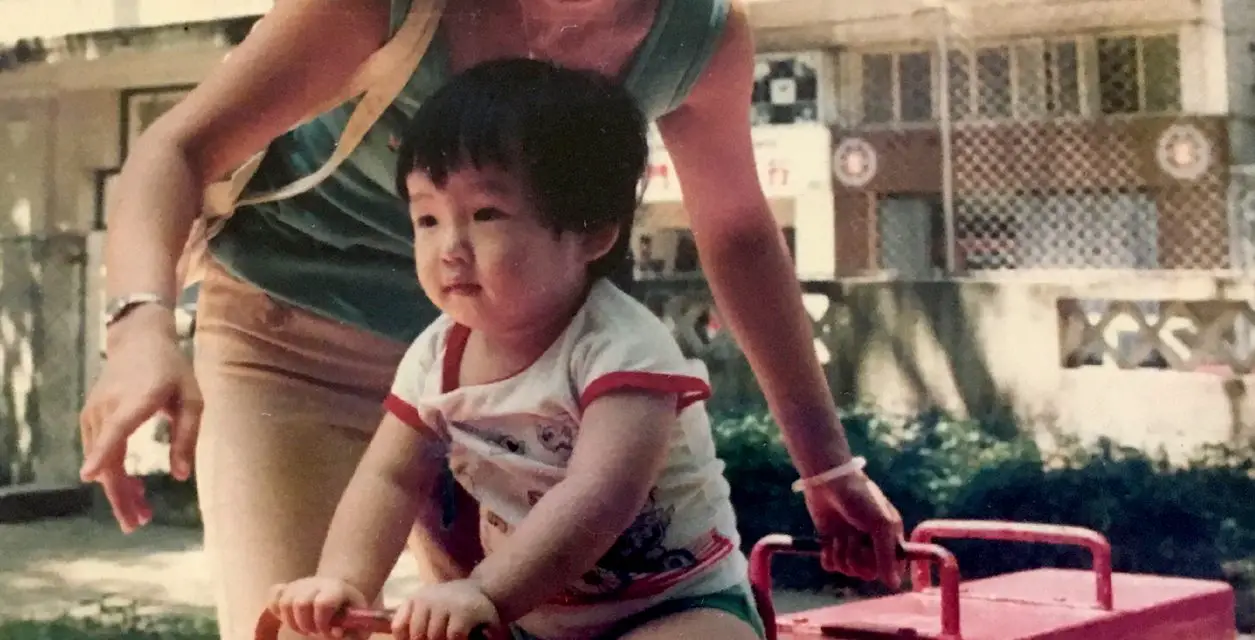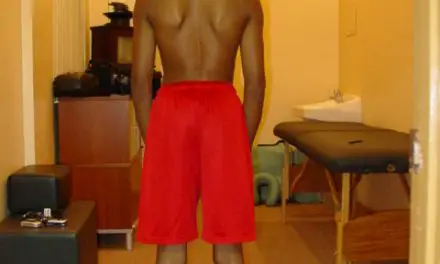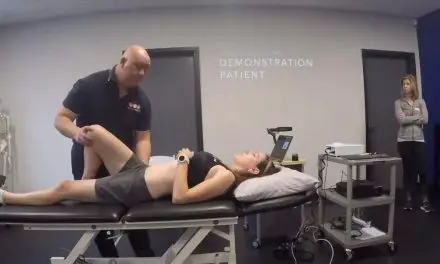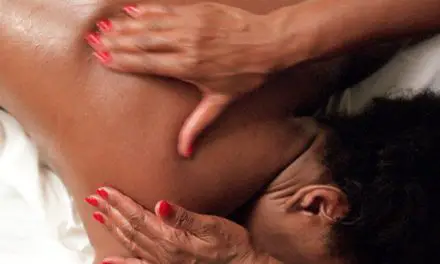I remember having low back pain as young as eight when I was visiting my family in Macau back in the summer of 1985. My mom, who also had chronic low back pain, said to me, “You can’t have back pain. You’re too young!”
She believed that children should not have such pain because their body parts are “new.” While this is a common belief among many parents and clinicians, pain research in the past 30-plus years have found that pain is much more than just tissue damage or structural “abnormalities” and that children and infants can feel pain like adults.
It’s also about how people cope and experience pain and what they know about it. It includes the culture and the environment that each person grew up in, which influence their beliefs and attitudes about pain.
This is no different among children and teens. In fact, research in the past 20 years have found that family and environmental factors can determine whether or not that kid you knew in third grade, who used to complain about headaches, will have developed such chronic pain by their 40th birthday.
Our understanding of pediatric pain has come a long way since the 1980s. Back then, infants and young children weren’t always given painkillers when they undergo surgery because many physicians thought they do not feel pain the way teens and adults do. With a push for changing pediatric medicine from parent advocacy and the media in the late 1980s, research in pediatric pain had skyrocketed.
Meanwhile, the biopsychosocial model of health by Dr. George Engel had gained a foothold in healthcare and research, which provided a more accurate (or “less wrong”) understanding of pain and health.
In the next three decades, emerging research reveals that parents, relatives and culture can take a toll on children’s chronic pain.
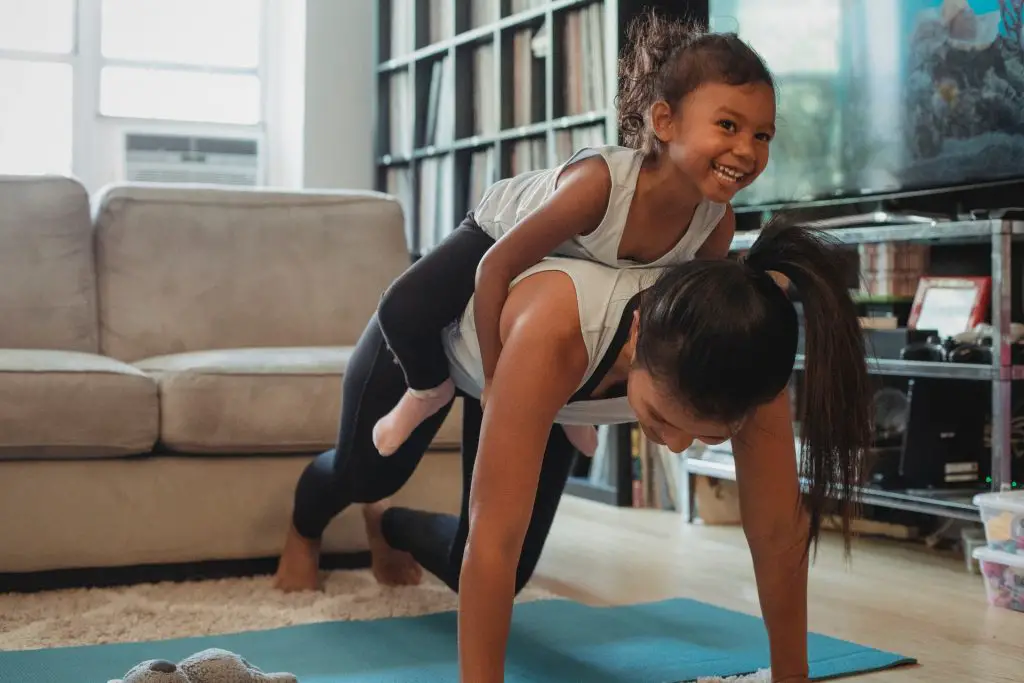
How likely a child experiences chronic pain in adulthood depends on their upbringing, including family and environment. (Photo by Kamaji Ogino via Pexels.)
Pediatric pain scale isn’t enough
The pediatric pain scale, which is based on the Wong-Baker Pain Rating Scale, is similar to the one adults might see in their doctor’s office. It’s based on a scale of 0 to 10 with 0 being “no hurt” and 10 being “hurts worst—in increments of 2’s.
Each number has a round face that progressively shows more distress as the numbers increase. While the pediatric pain scale is still widely accepted today, some research finds that it may not be as reliable as previously thought.
For example, a review of 12 studies of the pediatric pain scale found that hand-drawn faces “may provide inaccurate pain assessment results if a child has difficulty separating the feelings of pain and mood.” Smiling faces may also overestimate the pain intensity, and the child’s age may cause higher bias in a pain assessment.
Some researchers and clinicians think that relying on it too much may blind some of their colleagues to see the bigger, social picture of children’s pain experience.
Pediatric pain and parental influence
How parents and other caregivers respond to children’s chronic pain can influence how children cope, understand, and communicate about pain later in life.
Unlike most mild forms of acute pain, like a small bruise, pediatric chronic pain can cause teeth-clenching stress among parents and children, a vicious cycle that ping-pongs between both parties.
Parents of children with chronic pain tend to be as stressful and suffer similar mental health problems as the children in pain themselves. However, current research is uncertain whether these conditions were already predisposed and pain amplifies these behaviors.
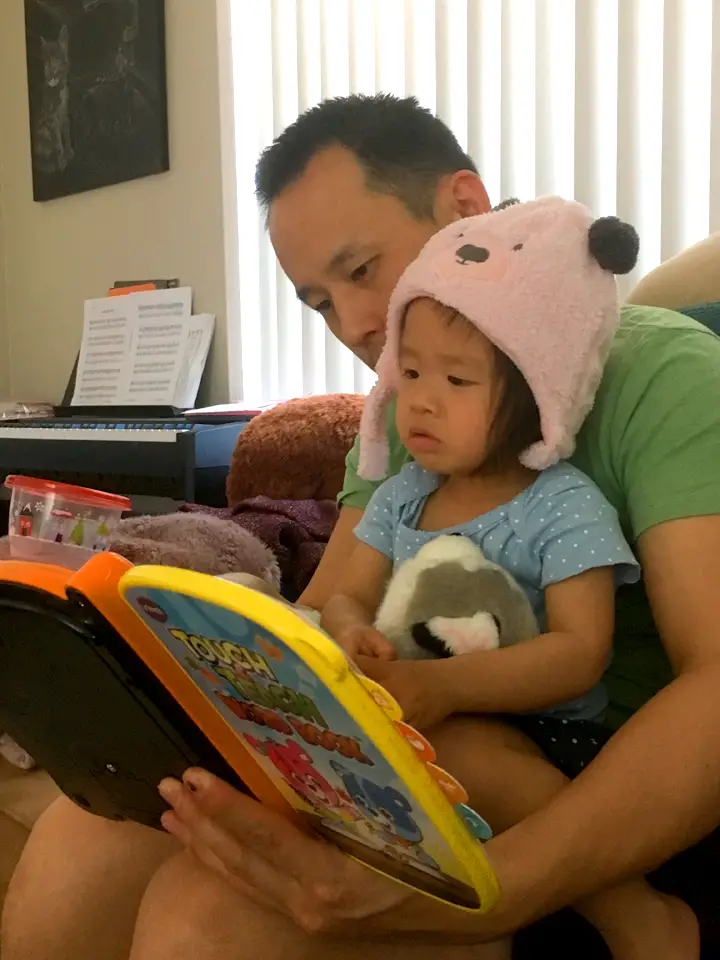
Gary Ng reads to his daughter, Maddie, in the spring of 2019 as she tries to understand what’s going on. (Photo by Nick Ng.)
Pediatric pain researchers found that there’s a two-way relationship between children with chronic pain and their parents or other caregivers who also have chronic pain. While there’s no clear-cut answer yet, some researchers are testing novel programs that target parents and caregivers for dealing with chronic pain.
“One area in which there has been some published work is in developing and testing parent interventions for youth with chronic pain,” Dr. Tonya Palermo explained in an email interview, who does research at the Department of Anesthesiology & Pain Medicine at the University of Washington. She also practices at Seattle Children’s Hospital.
“In my own research program, we completed testing of a new therapeutic approach for this population that we adapted from studies of caregivers of children with cancer.”
It’s called “Problem Solving Skills Training,” a step-by-step approach that helps reduce caregivers’ distress by teaching them to have confidence in identifying and solving problems in their family. It’s a structured therapy where parents learn steps of solving problems.
“We published a pilot trial of the intervention in 2016 finding positive results for the intervention in reducing parent distress,” Palermo said. “We also found that children also had reduced distress even though they didn’t participate in the treatment. This really highlights the bi-directional influence of child and parent emotional functioning and the importance of including parents in our therapies.”
Even though most of the chronic pain studied are headaches and abdominal pain, we could extrapolate these findings to musculoskeletal pain.
“There are more similarities than differences across chronic pain conditions in terms of psychosocial risk factors and importance of focusing on self-management of pain,” Palermo said. “Very similar predictors of development of musculoskeletal pain (including depression, sleep problems, family distress) have been identified and are equally important to address in psychological treatments. Many more studies are focusing on intervening with parents and this may enhance the effects of psychological treatments for pediatric chronic pain.”
Pediatric Pain Red Flags: Abuse and Trauma
Child abuse and trauma, including neglect and corporal punishment, are some of the red flags that clinicians should also consider in addition to the common symptoms of certain pediatric chronic pain.
Professor Robert Sapolsky, who is a neurobiologist and primatologist at Stanford University, argued that the classical debate of “Nature vs. nurture” (like “Coke vs. Pepsi”) is a false dichotomy because the problem in explaining animal and human behavior is not that simple.
In his 2006 book “Monkeyluv: And Other Essays on Our Lives as Animals,” Sapolsky wrote:
“The problem with ‘a’ gene-environment interaction is that there is no gene that does something. It only has a particular effect in a particular environment, and to say that a gene has a consistent effect in every environment is really only to say that it has a consistent effect in all the environments in which it has been studied to date.
“This has become ever more clear in studies of the genetics of behavior, as there has been increasing appreciation of environmental regulation of epigenetics, transcription factors, splicing factors, and so on.
“And this is most dramatically pertinent to humans, given the extraordinary range of environments—both natural and culturally constructed—in which we live.”
Relating to pediatric pain, this implies that we can’t blame on any single gene or trait that increases the likelihood of chronic pain. We have to look at the physical and social environments. Some recent pediatric pain research found that children and teens with higher experiences or exposure to trauma and abuse are more sensitive to pain than those with such lower experiences or none.
[Related: Corporal Punishment in Schools and Chronic Pain]
Psychologists Sophia You and Mary W. Meagher from Texas A&M University in College Station, Texas, recently found that having strong childhood trauma, abuse, and neglect could increase the risk of developing central sensitization—a major contribution to the chronic pain experience.
You and Meagher wrote that the constant wear-and-tear of the body from the repeated exposure to abuse or trauma “may alter the adaptive systems that heighten pain sensitivity and increase vulnerability to persistent pain states.”
In other words, children may just “give up” or “go numb” from having excessive stress due to sustained high levels of the stress hormone cortisol.
In one of their studies, You and Meagher found that those who had reported higher childhood adversity tend to have slower recovery of temporal summation of secondary pain (TSSP).
This is the gradual increase of pain due to repetitive stimulation, like placing a heating pad on your arm until it gets uncomfortable to the point of having pain.
Using heat on the test subjects’ thumb, they found those who had experienced trauma as children were much more sensitivity to pain and took almost twice as long for the pain to dissipate.
“My paper speaks to childhood adversity as a vulnerability factor to chronic pain,” You explained in an email interview. “I was able to demonstrate greater central sensitization in ‘healthy subjects with childhood adversity’ compared to the healthy counterpart. Central sensitization is believed to be involved in the development and maintenance of chronic pain.”
One mechanism that explains the slower recovery rate among the high-adversity group is that stress increases activity in a protein called kinase Cε among afferent nociceptors, as well as epinephrine and interleukin-6. (Interleukin-6 is a protein that can act as both a pro-inflammatory or anti-inflammatory contributor).
However, not much is known how childhood trauma and abuse cause these factors to transition to chronic pain during early adulthood.
“Early life stress can sensitize central pain processing,” You said. “Based on animal studies, stress hormones (cortisol, epinephrine) and proinflammatory cytokines play a significant role in this stress-related pain sensitization process. Therefore, learning stress management strategies will be important even in healthy athletes and young adults to reduce the risk of development of chronic pain in later life.”
Parents’ role in influencing chronic pain to kids
Most pediatric pain research tends to separate children’s pain experience from their parents’ pain experience as well as environmental and social factors that interplay the pain experience.
This goes back to the chicken-or-the-egg dilemma: Do parents’ pain influence their children’s pain or vice versa? If so, who influences more?
Some researchers in this realm recognized that this is an issue and began to explore. One recent study published in the Journal of Pain—led by Dr. Melanie Noel from the Department of Psychology at the University of Calgary in Alberta, Canada—hypothesized that parental behaviors have a direct association with pain among children.
Such factors include parents’ chronic pain status, pain frequency and intensity, mental health symptoms, amount of protectiveness, and catastrophization of pain. The researchers hypothesized that “all parental constructs would be uniquely associated with child pain and function and child psychological factors.”
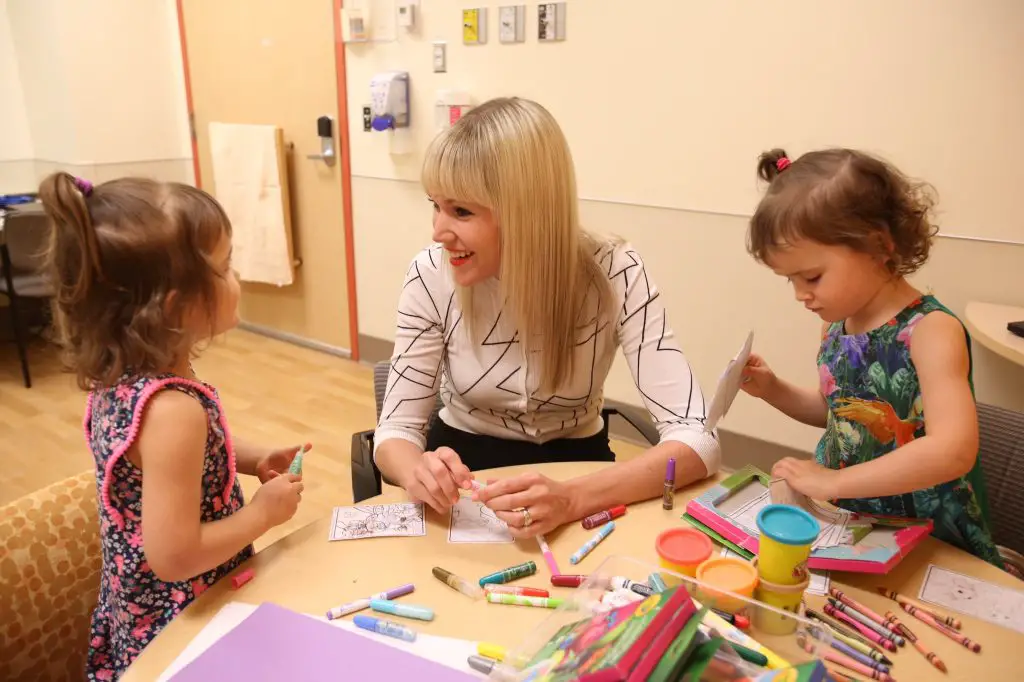
“Parents’ anxiety and how they were feeling prior to their children going to surgery was a powerful predictor to how those kids remember the surgery. Parents’ anxiety is more important [predictor] than how the children were feeling,” said Dr. Melanie Noel said, who is doing crafts with her daughters in 2019. (Photo courtesy of Melanie Noel.)
They found that the four domains of parental factors—chronic pain features, physical function, response, psychological factors—have a strong direct association with children’s pain, which builds on previous studies that showed similar results.
When a parent shows extreme emotional response to a child’s pain, that can affect their own pain and their child’s, for better or for worse.
Noel et al. also cited that their major strength of the study is the inclusion of the “parents’ own pain experiences and physical function as direct predictors of child pain and functioning,” which may likely influence children’s genetic risk and social learning behavior for chronic pain.
“Parents’ anxiety and how they were feeling prior to their children going to surgery was a powerful predictor to how those kids remember the surgery,” said Dr. Noel in a phone interview. “Parents’ anxiety is more important [predictor] than how the children were feeling. The power of parents’ mental health on their child’s pain experience has a long-lasting impact on how kids remember their pain experience, especially among younger children.”
Noel also mentioned that memory for pain isn’t like a tape recorder, and memories are susceptible to distortion.
“Some painful experience could be [worse] than it actually was, and some painful experience could have been not so bad yet the memory says it was very painful,” she explained.
Noel’s future research explores how memory among children can affect life-long experiences as adults.
“Can we alter those memories to improve how kids experience pain in the future? How you remember pain is one of the best predictors in how you will experience pain in the future. How you remember pain has a higher impact than what actually happened in pain experience prediction.”

Dr. Melanie Noel presents how memory affects children’s chronic pain experience at the 2020 San Diego Pain Summit on February 2020. (Photo by Nick Ng.)
Like most studies, there are a few limitations that we need to consider:
- Most of the parents were mothers (about 90%), so we don’t really know if the current findings apply to fathers and male caregivers;
- Most of the subjects were Caucasians (about 87%), so we don’t know if this would apply much to families with a different culture and don’t speak English;
- Because it’s a cross-sectional study, we don’t know if self-reports accurately reflect day-to-day experiences. Thus, we cannot firmly establish a causality or who contributes the most to chronic pain;
- Most of the pain reported were headaches and abdominal pain. (about 73%);
- More girls reported more pain intensity and frequency than boys.
“I think culture and how we socialize children, how we parent, and our belief about pain can influence how children experience pain,” Noel replied on the impact of culture and language. “We could learn a lot from understanding social understanding about pain, hospital management of pain, and how cultures approach parenting.”
She agreed that there needs to be more cross-cultural studies, yet there are universal characteristics on how children respond to pain and parental responses.
“Unfortunately very limited research is available on how culture, ethnicity, race, and language influence children’s experiences with chronic pain,” said Palermo. “In other conditions such as depression, research has shown that risk factors are similar across cultures but that there are some important considerations in how treatments are delivered that take into account differences in cultural meaning of symptoms. The role of parents may also differ in certain cultural contexts. This is an important area where more research is needed.”
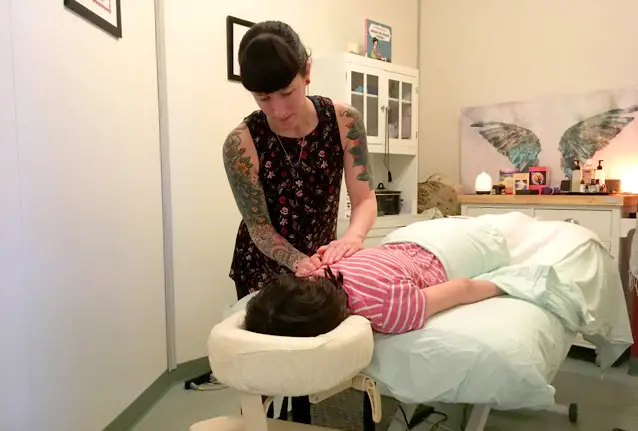
Kerri-Ann Hutton, RMT, treats a young patient at her clinic in Kelowna, B.C. (Photo courtesy of Kerri-Ann Hutton.)
Palermo and her team of researchers are conducting several ongoing studies that examine various parental and familial factors. One of their focus is on the continuing role of parents in the care of their kids who are in their late teens and twenties.
“I think it is important to recognize that parents can play an important role in children’s treatment and that this may need to be individualized based on the child’s developmental status, family preferences, and other psychosocial needs,” Palermo said. “Physiotherapists and massage therapists can help educate children and parents about taking an active role in self-management of pain and can recognize and challenge beliefs that the child or parent has that may be causing a high level of distress.”
This story was originally published in the Spring 2019 issue of Massage & Fitness Magazine. Updated for 2022.
A native of San Diego for nearly 40 years, Nick Ng is an editor of Massage & Fitness Magazine, an online publication for manual therapists and the public who want to explore the science behind touch, pain, and exercise, and how to apply that in their hands-on practice or daily lives.
An alumni from San Diego State University with a B.A. in Graphic Communications, Nick also completed his massage therapy training at International Professional School of Bodywork in San Diego in 2014.
When he is not writing or reading, you would likely find him weightlifting at the gym, salsa dancing, or exploring new areas to walk and eat around Southern California.

